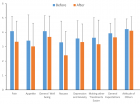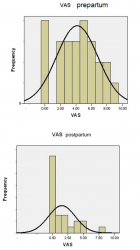Abstract
Research Article
Design and validation of an Index to predict the development of Hypertensive Cardiopathy
Alexis Álvarez-Aliaga*, Andrés José Quesada-Vázquez, Alexis Suárez-Quesada and David de Llano Sosa
Published: 16 February, 2018 | Volume 3 - Issue 1 | Pages: 008-022
Introduction: The high morbidity and mortality by hypertensive cardiopathy demand the construction and validation of tools to stratify the risk of developing this condition.
Objective: To design and validate an index, based on risk factors, that permits to predict the development of hypertensive cardiopathy in patients with a diagnosis of essential arterial hypertension.
Methods: A prospective cohort study was done in hypertensive patients assisted at the specialized arterial hypertension physicians’ office of the “Carlos Manuel de Céspedes” Specialty Policlinic attached to the General University Hospital, Bayamo Municipality, Granma Province, Cuba from January 1st, 2010 to December 31, 2016. Internal and external validity and the internal consistency of the index were determined.
Results: The index sensitivity was of 97, 20 (IC: 93, 93-94.09) and specificity of 65, 38 (IC: 76, 25-76, 20). Both the index discriminative capacity (area under the ROC curve= 0,944; interval of confidence: 0.932-0.956; p<0.0005) and calibration (p=0.751) were adequate.
Conclusions: The present study proposes an index to predict the risk of developing hypertensive cardiopathy, with adequate discriminative capacity and calibration (external validity). The index can be used as a tool of clinical and epidemiological surveillance since it permits to identify subjects with greater probability of developing the condition and to stratify the risk.
Read Full Article HTML DOI: 10.29328/journal.jccm.1001022 Cite this Article Read Full Article PDF
References
- Chobanian AV, Bakris GL, Black HR, Cushman WC, Green LA, et al. The Seventh Report of the Joint National Committee on Prevention, Detection, Evaluation, and Treatment of High Blood Pressure. The JNC 7 report. 2003; 289: 2560-2572. Ref.: https://goo.gl/s9MtBw
- República de Cuba. Anuario Estadístico de Salud; 2016. [citado 10 abril 2017]. Disponible en.
- Tientcheu D, Ayers C, Das SR, McGuire DK, de Lemos JA, et al. Target organ complications and cardiovascular events associated with masked hypertension and white-coat hypertension. Analysis from the Dallas heart study. Am Coll Cardiol. 2015; 66: 2159-2169. Ref.: https://goo.gl/B4sMN3
- Díez J, Frohlich E D. A translational approach to hypertensive heart disease. Hypertension. 2010; 55: 1-8. Ref.: https://goo.gl/xNGLyg
- Mancia G, Fagard R, Narkiewicz K, Redon J, Zanchetti A, et al. Guía de práctica clínica de la ESH/ESC 2013 para el manejo de la hipertensión arterial. Rev Esp Cardiol. 2013; 66: 880.
- Mancia G, Laurent S, Agabiti-Rosei E, Ambrosioni E, Burniere M, et al. Reappraisal of European guidelines on hypertension management: A European Society of Hypertension Task Force document. J Hypertens. 2009; 27: 2121-2158. Ref.: https://goo.gl/HBrVk9
- Maione A, Annemans L, Strippoli G. Proteinuria and clinical outcomes in hypertensive patients. Am J Hypertens. 2009; 22: 1137-1147. Ref.: https://goo.gl/w2pMxY
- Angeli F, Ambrosio G. Mecanismos de la hipertrofia ventricular izquierda en la hipertensión: más que solo la presión arterial. Rev Argent Cardiol. 2015; 83: 6-7. Ref.: https://goo.gl/1BKVsC
- Harbaoui B, Courand PY, Defforges A, Khettab F, Milon H, et al. Cumulative effects of several target organ damages in risk assessment in hypertension. Am J Hypertens. 2016; 29: 234-244. Ref.: https://goo.gl/MFLhNw
- Wang SX, Xue H, Zou YB, Sun K, Fu CY, et al. Prevalence and risk factors for left ventricular hypertrophy and left ventricular geometric abnormality in the patients with hypertension among Han Chinese. Chin Med J. 2012; 125: 21-26. Ref.: https://goo.gl/SesKhT
- Sharman J E. New insights into cardiovascular risk from the exercise central waveform. Artery Res. 2009; 2: 132-137. Ref.: https://goo.gl/Zd9a6A
- García Iglesias A, Lozano Alonso J E, Álamo Sanz R, Vega Alonso T. Factores asociado al control de la presión arterial en la cohorte del estudio del riesgo de enfermedad cardiovascular en Castilla y León (RECCyL). Hipertens Riesgo Vasc. 2015; 32: 48-55. Ref.: https://goo.gl/AAKq4U
- Dévereux RB, Reichek N. Echocardiographic determination of left ventricular mass in man. Anatomic validation of the method. Circulation. 1977; 55: 613-618. Ref.: https://goo.gl/VwxWXY
- Khouri MG, Peshock RM, Ayers CR, de Lemos JA, Drazner MH. A 4-tiered classification of left ventricular hypertrophy based on left ventricular geometry: The Dallas Heart Study. Circ Cardiovasc Imaging. 2010; 3: 164-171. Ref.: https://goo.gl/8Fnptm
- Fuster V, Rydén L E, Cannom D S, Crijns H J, Curtis A B, et al. 2011 ACCF/AHA/HRS focused updates incorporated into the ACC/AHA/ESC 2006 guidelines for the management of patients with atrial fibrillation. J Am Coll Cardiol. 2011; 123: 104-123. Ref.: https://goo.gl/uYTEgW
- Pérez Caballero MD, Dueñas Herrera A, Alfonso Guerra JP, Vázquez Vigoa A, Navarro Despaigne D, et al. Hipertensión arterial. Guía para la prevención, diagnóstico y tratamiento. Comisión Nacional Técnica Asesora del Programa de Hipertensión Arterial. La Habana: Editorial Ciencias Médicas. 2008. Ref.: https://goo.gl/d9zaUu
- Whelton S, Chin A, Xin X, He J. Effect of aerobic exercise on blood pressure: a meta-analysis of randomized, controlled trials. Ann Intern Med. 2002; 136: 493-503. Ref.: https://goo.gl/FsyiuG
- Cabrera de León A, Rodríguez-Pérez C, Rodríguez-Benjumeda M, Anía-Lafuente B, Brito-Díaz B, et al. Sedentarismo: tiempo de ocio activo frente a porcentaje del gasto energético. Rev Esp Cardiol. 2007; 60: 244-250. Ref.: https://goo.gl/9V1PG6
- Zhao W, Hasegawa K, Chen J. Part A. Recent advances in dietary assessment tools. The use of food-frequency questionnaires for various purposes in China. Public Health Nutrition. 2002; 5, 829-833. Ref.: https://goo.gl/Romh5u
- Egan BM, Zhao Y, Axon RN. US trends in prevalence, awareness, treatment, and control of hypertension, 1988-2008. JAMA. 2010; 303: 2043-2050. Ref.: https://goo.gl/JHFMTu
- Álvarez Aliaga A, González Aguilera JC, Maceo Gómez LR. Factores asociados al desarrollo de la cardiopatía hipertensiva: un estudio de cohorte, en Bayamo, Cuba. Medwave. 2016; 16. Ref.: https://goo.gl/csGC8P
- Moriyama IM. Problems in the measurement of health status. En: Sheldon EB, Moore W. eds. Indicators of social change: concepts and measurements. New York: Rusell Sage fundation. 1968: 573-599.
- D'Agostino RB, Grundy S, Sullivan LM, Wilson P, for the CHD Risk Prediction Group. Validation of the Framingham Coronary Heart Disease Prediction Scores. Results of a multiple ethnic groups investigation. JAMA. 2001; 286:180-187. Ref.: https://goo.gl/UBzXFm
- Álvarez Aliaga A, González Aguilera JC, Quesada Vázquez AJ, Frómeta Guerra A, Cisneros Sánchez L, Maceo Gómez LR. Índice predictivo para la cardiopatía hipertensiva. Rev Cubana de Med. 2010; 49: 311-329. Ref.: https://goo.gl/2pBkEe
- Drazner M H. The Progression of Hypertensive Heart Disease. Circulation. 2011; 123: 327-334. Ref.: https://goo.gl/chYmgm
- Cuspidi C, Giudici V, Negri F, Meani S, Sala C, et al. Improving cardiovascular risk stratification in essential hypertensive patients by indexing left ventricular mass to height(2.7). J Hypertens. 2009; 27: 2465-2471. Ref.: https://goo.gl/Jvobsg
- Gu Q, Dillon CF, Burt VL, Gillum RF. Association of hypertension treatment and control with all-cause and cardiovascular disease mortality among US adults with hypertension. Am J Hypertens. 2010; 23: 38-45. Ref.: https://goo.gl/k3x92g
- Peralta CA, Katz R, Newman AB, Psaty BM, Odden MC. Systolic and diastolic blood pressure, incident cardiovascular events, and death in elderly persons: the role of functional limitation in the Cardiovascular Health Study. Hypertension.2014; 64: 472-480. https://goo.gl/d2GVgz
- Álvarez Aliaga A, González Aguilera JC. Algunos factores de riesgo de la cardiopatía hipertensiva. Rev Cubana de Med. 2009; 48: 139-151. Ref.: https://goo.gl/vSJHBL
- De la Noval García R, Armas Rojas NB, de la Noval González I, Fernández González Y, Pupo Rodríguez HB, et al. Estimación del riesgo cardiovascular global en una población del área de salud Mártires del Corynthia. Ciudad Habana, Cuba. Rev Cubana Cardiol Cir Cardiovasc. 2011; 17: 62-68. Ref.: https://goo.gl/77vWvG
- Armas Rojas NB, De la Noval García R, Dueñas Herrera A, Castillo Núñez JC, Suárez Medina R, et al. Estimación del riesgo cardiovascular mediante tablas de la Organización Mundial de la Salud. Área de salud “Héroes del Moncada”. 2011. Rev Cubana Cardiol Cir Cardiovasc. 2014; 20. Ref.: https://goo.gl/x1U0K2
- D’Agostino RB, Vasan RS, Pencina MJ, Wolf PA, Cobain M, et al. General cardiovascular risk profile for use in primary care the Framingham heart study. Circulation. 2008; 117: 743-753. Ref.: https://goo.gl/XgFgAh
- Ang DSC, Fahey TP, Wright GA, Struthers AD. Development and validation of a clinical score to identify echocardiographic left ventricular hypertrophy in patients with cardiovascular disease. Am J Hypertens.2008; 21: 1011-1017. Ref.: https://goo.gl/8VWSLa
- Creemers EE, Pinto YM. Molecular mechanisms that control interstitial fibrosis in the pressure-overloaded heart. Cardiovasc Res. 2011; 89: 265-272. Ref.: https://goo.gl/fJ85zY
- Drazner MH. The Progression of Hypertensive Heart Disease. Circulation. 2011; 123: 327-334. Ref.: https://goo.gl/chYmgm
- Feinstein AR, Cicchetti DV. High agreement but low kappa: I. The problem of two paradoxes. J Clin Epidemiol. 1990; 43: 543-549. Ref.: https://goo.gl/8NisKG
- Streiner DL, Norman GR. Health measurement scales. A practical guide to their development and use. Oxford: Oxford University Press; 1989: 144-161.
- García Cadena CH. La medición en las ciencias sociales y la psicología, en estadística con SPSS y metodología de la investigación de René Landeros Hernández y Mónica T González Ramírez. México, Trillas (comp). 2006. Ref.: https://goo.gl/RY1Qad
Figures:

Figure 1
Similar Articles
-
Left Atrial Remodeling is Associated with Left Ventricular Remodeling in Patients with Reperfused Acute Myocardial InfarctionChristodoulos E. Papadopoulos*,Dimitrios G. Zioutas,Panagiotis Charalambidis,Aristi Boulbou,Konstantinos Triantafyllou,Konstantinos Baltoumas,Haralambos I. Karvounis,Vassilios Vassilikos. Left Atrial Remodeling is Associated with Left Ventricular Remodeling in Patients with Reperfused Acute Myocardial Infarction. . 2016 doi: 10.29328/journal.jccm.1001001; 1: 001-008
-
Mid-Ventricular Ballooning in Atherosclerotic and Non-Atherosclerotic Abnormalities of the Left Anterior Descending Coronary ArteryStefan Peters*. Mid-Ventricular Ballooning in Atherosclerotic and Non-Atherosclerotic Abnormalities of the Left Anterior Descending Coronary Artery. . 2016 doi: 10.29328/journal.jccm.1001002; 1:
-
Concentration Polarization of Ox-LDL and Its Effect on Cell Proliferation and Apoptosis in Human Endothelial CellsShijie Liu*,Jawahar L Mehta,Yubo Fan,Xiaoyan Deng,Zufeng Ding*. Concentration Polarization of Ox-LDL and Its Effect on Cell Proliferation and Apoptosis in Human Endothelial Cells. . 2016 doi: 10.29328/journal.jccm.1001003; 1:
-
Intermittent Left Bundle Branch Block: What is the Mechanism?Hussam Ali*,Riccardo Cappato. Intermittent Left Bundle Branch Block: What is the Mechanism?. . 2017 doi: 10.29328/journal.jccm.1001004; 2:
-
Congenital Quadricuspid Aortic Valve, a Rare Cause of Aortic Insufficiency in Adults: Case ReportCyrus Kocherla*,Kalgi Modi. Congenital Quadricuspid Aortic Valve, a Rare Cause of Aortic Insufficiency in Adults: Case Report. . 2017 doi: 10.29328/journal.jccm.1001005; 2: 003-007
-
Short and Medium-Term Evaluation of Patients in Coronary Post-Angioplasty: Préliminary results at the Cardiology Department of the Hospital University Aristide Le Dantec of Dakar (Senegal): Study on 38 CasesDioum M*,Aw F,Masmoudi K,Gaye ND,Sarr SA,Ndao SCT, Mingou J,Ngaidé AA,Diack B,Bodian M,Ndiaye MB,Diao M,Ba SA. Short and Medium-Term Evaluation of Patients in Coronary Post-Angioplasty: Préliminary results at the Cardiology Department of the Hospital University Aristide Le Dantec of Dakar (Senegal): Study on 38 Cases. . 2017 doi: 10.29328/journal.jccm.1001006; 2: 008-012
-
Indications and Results of Coronarography in Senegalese Diabetic Patients: About 45 CasesNdao SCT*,Gaye ND,Dioum M,Ngaide AA,Mingou JS,Ndiaye MB, Diao M,Ba SA. Indications and Results of Coronarography in Senegalese Diabetic Patients: About 45 Cases. . 2017 doi: 10.29328/journal.jccm.1001007; 2: 013-019
-
Procedure utilization, latency and mortality: Weekend versus Weekday admission for Myocardial InfarctionNader Makki,David M Kline,Arun Kanmanthareddy,Hansie Mathelier,Satya Shreenivas,Scott M Lilly*. Procedure utilization, latency and mortality: Weekend versus Weekday admission for Myocardial Infarction. . 2017 doi: 10.29328/journal.jccm.1001008; 2: 020-025
-
Spontaneous rupture of a giant Coronary Artery Aneurysm after acute Myocardial InfarctionOğuzhan Çelik,Mucahit Yetim,Tolga Doğan,Lütfü Bekar,Macit Kalçık*,Yusuf Karavelioğlu. Spontaneous rupture of a giant Coronary Artery Aneurysm after acute Myocardial Infarction. . 2017 doi: 10.29328/journal.jccm.1001009; 2: 026-028
-
Thrombolysis, the only Optimally Rapid Reperfusion TreatmentVictor Gurewich*. Thrombolysis, the only Optimally Rapid Reperfusion Treatment. . 2017 doi: 10.29328/journal.jccm.1001010; 2: 029-034
Recently Viewed
-
Exophthalmos Revealing a Spheno Temporo Orbital MeningiomaHassina S*, Krichene MA, Hazil Z, Bekkar B, Hasnaoui I, Robbana L, Bardi S, Akkanour Y, Serghini L, Abdallah EL. Exophthalmos Revealing a Spheno Temporo Orbital Meningioma. Int J Clin Exp Ophthalmol. 2024: doi: 10.29328/journal.ijceo.1001055; 8: 001-003
-
Value of electrocardiographic T wave inversion in lead aVL in prediction of Mid Left Anterior Descending Stenosis in patients with stable Coronary Artery diseaseGehan Magdy*,Awad Yousef. Value of electrocardiographic T wave inversion in lead aVL in prediction of Mid Left Anterior Descending Stenosis in patients with stable Coronary Artery disease. J Cardiol Cardiovasc Med. 2017: doi: 10.29328/journal.jccm.1001015; 2: 056-062
-
Calciphylaxis in HemodialysisLuca Sgarabotto*, Paola Baldini Anastasio, Nicola Marchionna, Monica Zanella. Calciphylaxis in Hemodialysis. J Clini Nephrol. 2023: doi: 10.29328/journal.jcn.1001107; 7: 044-046
-
Metabolic syndrome: A case reportDragan Klaric,Marta Martinis*,Marta Klaric. Metabolic syndrome: A case report. Ann Clin Endocrinol Metabol. 2021: doi: 10.29328/journal.acem.1001022; 5: 031-035
-
Utilization of Molecular Simulation Applications for Stability Testing of Anthocyanin Compounds in Black ElderberryRichard Benedict*. Utilization of Molecular Simulation Applications for Stability Testing of Anthocyanin Compounds in Black Elderberry. Arch Biotechnol Biomed. 2023: doi: 10.29328/journal.abb.1001035; 7: 012-017
Most Viewed
-
Evaluation of Biostimulants Based on Recovered Protein Hydrolysates from Animal By-products as Plant Growth EnhancersH Pérez-Aguilar*, M Lacruz-Asaro, F Arán-Ais. Evaluation of Biostimulants Based on Recovered Protein Hydrolysates from Animal By-products as Plant Growth Enhancers. J Plant Sci Phytopathol. 2023 doi: 10.29328/journal.jpsp.1001104; 7: 042-047
-
Sinonasal Myxoma Extending into the Orbit in a 4-Year Old: A Case PresentationJulian A Purrinos*, Ramzi Younis. Sinonasal Myxoma Extending into the Orbit in a 4-Year Old: A Case Presentation. Arch Case Rep. 2024 doi: 10.29328/journal.acr.1001099; 8: 075-077
-
Feasibility study of magnetic sensing for detecting single-neuron action potentialsDenis Tonini,Kai Wu,Renata Saha,Jian-Ping Wang*. Feasibility study of magnetic sensing for detecting single-neuron action potentials. Ann Biomed Sci Eng. 2022 doi: 10.29328/journal.abse.1001018; 6: 019-029
-
Pediatric Dysgerminoma: Unveiling a Rare Ovarian TumorFaten Limaiem*, Khalil Saffar, Ahmed Halouani. Pediatric Dysgerminoma: Unveiling a Rare Ovarian Tumor. Arch Case Rep. 2024 doi: 10.29328/journal.acr.1001087; 8: 010-013
-
Physical activity can change the physiological and psychological circumstances during COVID-19 pandemic: A narrative reviewKhashayar Maroufi*. Physical activity can change the physiological and psychological circumstances during COVID-19 pandemic: A narrative review. J Sports Med Ther. 2021 doi: 10.29328/journal.jsmt.1001051; 6: 001-007

HSPI: We're glad you're here. Please click "create a new Query" if you are a new visitor to our website and need further information from us.
If you are already a member of our network and need to keep track of any developments regarding a question you have already submitted, click "take me to my Query."






















































































































































